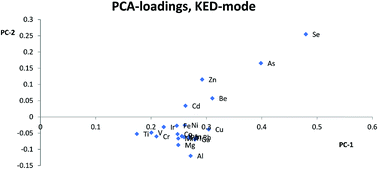Internal standards in inductively coupled plasma mass spectrometry using kinetic energy discrimination and dynamic reaction cells†
Abstract
ICP-MS is a sensitive element analysis technique used for analyzing several different sample types. This can result in difficult matrixes which can affect both physical parameters and create overlaps of analyte elements. Some of the possible overlaps can be reduced by the use of reaction and/or collision cells, while the use of internal standards can help with reducing the physical interferences caused by a matrix. While both internal standardization and the use of cells have been studied separately, their effects on each other have not been investigated earlier. In this study ICP-MS was used to analyze 24Mg, 27Al, 47Ti, 49Ti, 51V, 52Cr, 53Cr, 55Mn, 57Fe, 59Co, 60Ni, 61Ni, 62Ni, 63Cu, 65Cu, 66Zn, 67Zn, 75As, 78Se, 82Se, 111Cd, and 208Pb with 9Be, 89Y, 69Ga, 103Rh, 115In, 193Ir, and 205Tl as internal standards with high concentrations of either HNO3, PBS-buffer, or Triton X-100 as the matrix, in reaction-, collision- and standard-cell modes. This was done to investigate which internal standards would compensate matrix effects in different cell modes. All internal standards, except Be, compensated fairly well (relative sensitivity RSD < 10%) even for severe matrix effects for most elements regardless of similarity in mass in the different cell modes. For Zn, As and Se no proper internal standard could be found, of the ones investigated.

- This article is part of the themed collection: JAAS Recent HOT articles


 Please wait while we load your content...
Please wait while we load your content...